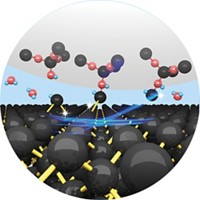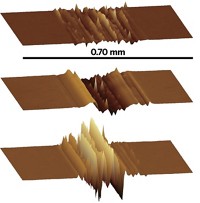Advertisement
Grab your lab coat. Let's get started
Welcome!
Welcome!
Create an account below to get 6 C&EN articles per month, receive newsletters and more - all free.
It seems this is your first time logging in online. Please enter the following information to continue.
As an ACS member you automatically get access to this site. All we need is few more details to create your reading experience.
Not you? Sign in with a different account.
Not you? Sign in with a different account.
ERROR 1
ERROR 1
ERROR 2
ERROR 2
ERROR 2
ERROR 2
ERROR 2
Password and Confirm password must match.
If you have an ACS member number, please enter it here so we can link this account to your membership. (optional)
ERROR 2
ACS values your privacy. By submitting your information, you are gaining access to C&EN and subscribing to our weekly newsletter. We use the information you provide to make your reading experience better, and we will never sell your data to third party members.
Materials
Tribology All Around
Meeting highlights how friction triggers molecular-scale changes in adhesive tape, cosmetics, and more
by Mitch Jacoby
December 7, 2009
| A version of this story appeared in
Volume 87, Issue 49
It happens every time you sit down, stand up, and take a step. It happens when you start your car engine, put it in gear, drive, and stop. During all of those mundane activities, pairs of solid surfaces, such as those of shoe soles and floors and furniture upholstery and clothing, slide past one another, thereby triggering bond-breaking and bond-making events at the interfaces.
Molecular-scale wear and tear and other effects of rubbing may go unnoticed by some scientists. But to tribologists, specialists in the physical and chemical phenomena associated with friction, wear, and lubrication, these interfacial processes take center stage.
A number of tribologists met at the annual American Vacuum Society meeting in San Jose, Calif., last month to talk shop and report on their latest results. The systems they described and the methods employed for studying them varied widely. Some scientists reported on tribology of materials found in mechanical systems used in uncommon applications. Others described work that delves into unusual properties of common household items that nevertheless remain unusual objects of study among tribologists.
Mention the phrase "adhesive tape" and surely most people think of the ubiquitous rolls of sticky stuff with 101 home and office uses. But not Seth J. Putterman. He thinks X-rays.
Putterman's research group in the physics department of the University of California, Los Angeles, demonstrated that the everyday act of unrolling commercial tape—simply peeling a strip of it from the underlying roll—causes friction-based events that lead to emission of light and flashes of X-rays (Nature 2008, 455, 1089).
Putterman explained that in the course of exploring energy-focusing phenomena, one of his main areas of research, he was intrigued to learn that in the 1950s researchers had proposed that peeling tape could induce this type of high-energy photon emission. The half-century-old studies had drawn little if any attention, however, because they were published in Russian and not translated. Even as far back as 1930, other researchers had suggested that highly energetic bursts of light could be generated by simply stripping apart sheets of mica.
The idea that two surfaces in relative motion can be a source of visible light—a process known as triboluminescence—has been known for ages. That phenomenon is invoked to explain the sparks sometimes observed when Wint-O-Green Life Savers are chewed or crushed in the dark. But could the small mechanical force needed to pull a bit of tape from a roll generate X-rays? "This just seemed too good to be true," Putterman remarked. "We wanted to see it for ourselves."
So the UCLA physicist together with postdocs Carlos G. Camara and Juan V. Escobar and coworkers built an apparatus for controllably transferring common adhesive tape from reel to reel under vacuum and for analyzing emission of X-rays, if indeed any are emitted. As it turns out, plenty of X-rays are emitted.

The team found that unrolling tape at a relatively slow rate—just a few centimeters per second—simultaneously leads to visible light and X-ray emission from the spot that the tape separates from the roll. They showed that the X-rays are intense enough to image the bones in a finger by exposing commercial dental X-ray film to the tape-peeling apparatus for about 1 second. Further study revealed that this tribological process induces nanosecond bursts of X-rays with a peak energy of about 15 keV.
Exactly what drives X-ray emission from peeling adhesive tape remains unclear. To begin with, the sticking action of tape is generally understood to be based on notoriously weak van der Waals forces. And a closeup view of the micrometer-sized region from which the tape separates from the roll reveals that the peeling process forms a messy web of gooey adhesive filaments—not the type of medium typically at the heart of high-energy processes. "I find it amazing," Putterman remarked, "that from this complex tangle of strings and the weakest forces in chemistry you get a collective blast of 100,000 X-ray photons in mere nanoseconds."
Although there is no first-principles theory of tribology that accounts for these observations, Putterman's group offers a phenomenological explanation. In their model, the peeling action causes the sticky acrylic adhesive to accumulate positive charge and the polyethylene roll negative charge. Electric fields between the separating faces increase until they reach a value that triggers discharges. When tape is peeled under vacuum, which reduces the concentration of air molecules that alter the discharge process, the discharges cause electrons to slam into the positively charged surface with enough energy to generate X-rays.

In their ongoing investigation, the UCLA group has sliced commercial rolls of tape to a width of about 1 mm and finds that these miniature rolls also function as nanosecond X-ray generators. Putterman proposed that this work could lead to simple and low-cost X-ray sources for scientific research and medical imaging. On a more fundamental level, he proposed that X-ray emission could serve as a novel probe of basic processes in tribology.
Household and office products are common items, but unusual systems for tribology investigations. Nanoscale studies of skin are even more unusual in that regard. Graduate student Wei Tang and Bharat Bhushan, a professor of mechanical engineering at Ohio State University, use atomic force microscopy methods to probe nanoscale tribological properties of various skin creams and their ingredients, including glycerin and lanolin oil.
Tang pointed out that the perception of tactile properties—like the softness of newly moisturized skin—is often mediated by vibrations sensed by fingers rubbed across a surface. That sensation is strongly dependent on surface roughness, friction, and adhesion between fingers and skin. By using untreated and cream-treated samples of rat skin as model skin samples, the team found that skin creams can reduce skin's surface roughness and increase its hydrophilicity. They also observed that treating skin with cream increases its coefficient of friction even though it is perceived to be smoother than untreated skin. In addition, the group found that the coefficient of friction and adhesive force depend on properties such as cream film thickness, temperature, and relative humidity (Colloids Surf. B, DOI: 10.1016/j.colsurfb.2009.09.039).
Tribology of office supplies and cosmetic products weren't the only topics discussed at the meeting. Susan B. Sinnott, a materials science professor at the University of Florida, Gainesville, reported on her group's work on polytetrafluoroethylene (PTFE), a solid lubricant and low-friction material used in nanocomposite form in space-based applications. The material is found in actuators that unfold and position the solar panels of satellites. One important shortcoming of PTFE is its high wear rate. To better understand that property and related ones, Sinnott, graduate student Peter R. Barry, and coworkers developed computational methods that simulate tribological interactions at interfaces between PTFE surfaces in sliding contact.

One key finding is that wear and friction depend on polymer chain orientation and the relative direction of sliding. When two PTFE crystals form an interface with their polymer chains aligned in parallel and slide along the direction of the chain axes, the crystals experience little wear, Sinnott noted. In contrast, perpendicular sliding—even just a few nanometers—quickly leads to increased friction and molecular-scale wear, as evidenced in the simulations by misaligned and broken polymer chains and accumulation of molecular debris at the interface.
The nature and thickness of lubricant films at the interface also play a direct role in mediating friction and wear. The Florida group investigated several fluorocarbon lubricants at a variety of film thicknesses. The group's simulation videos show that at a thickness of a single molecular layer, neither C2F6 nor C8F18 provides sliding PTFE crystals with significant resistance to wear. At just four monolayers however, the reduction in wear and friction is pronounced. Both compounds protect the PTFE interface, but the C2F6 film almost entirely eliminates frictional forces.
Further comparison of the two compounds revealed a key mechanistic difference that may underlie the enhanced wear protection provided by the C2 compound. Unlike C8F18 molecules, which "try" to align themselves along the PTFE sliding direction, C2F6 molecules at the interface roll and tumble rather freely, thereby providing superior lubrication and wear protection.
For ordinary and unusual systems alike, everyday actions bring material surfaces into sliding contact. Pistons, gears, and other machine parts seem like obvious focus points for lubrication and friction studies. But tribology isn't limited to Earth-bound machines or to mechanical gadgets of any type. Investigating interfaces in atypical systems sometimes reveals unexpected effects of molecular-scale wear and tear.




Join the conversation
Contact the reporter
Submit a Letter to the Editor for publication
Engage with us on Twitter